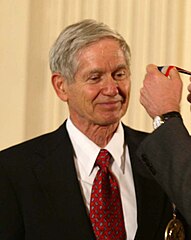Charles David Keeling
 Charles D. Keeling odznaczany przez George'a Busha Narodowym Medalem Nauki (2002) | |
| Data i miejsce urodzenia | 20 kwietnia 1928 |
|---|---|
| Data i miejsce śmierci | |
| Zawód, zajęcie | |
| Narodowość | |
| Tytuł naukowy | profesor |
| Alma Mater | Uniwersytet Illinois w Urbanie i Champaign, Northwestern University |
| Uczelnia | Scripps Institution of Oceanography, Uniwersytet w Heidelbergu, Uniwersytet w Bernie |
| Odznaczenia | |
Charles David Keeling (ur. 20 kwietnia 1928 w Scranton (Pensylwania), zm. 20 czerwca 2005 w Hamilton (Montana)) – amerykański klimatolog, doktorant w Northwestern University (Illinois) (1954), profesor chemii w kalifornijskim Scripps Institution of Oceanography (1968). Profesor wizytujący na Uniwersytecie w Heidelbergu (lata 1969-1970) oraz na Uniwersytecie Berneńskim (lata 1979–1980). Wyniki jego wieloletnich ciągłych pomiarów stężenia dwutlenku węgla w atmosferze ziemskiej[1], wykonanych od 1958 roku w obserwatorium na Mauna Loa, bywają uznawane za najważniejszy zestaw danych środowiskowych, zebranych w XX wieku. Zbiór jest znany jako tzw. krzywa Keelinga[2][3]. Mimo wysokiej oceny znaczenia tych wyników, co znajduje wyraz m.in. w rosnącej liczbie cytowań, inne ośrodki długo nie podejmowały podobnych badań, wymagających wytrwałości i kosztownych[4].
Keeling zajmował się również tematyką różnorodności biologicznej. Jest autorem ponad 100 prac naukowych[5][6].
Odznaczenia
- 1981 – Nagroda Drugiej Połowy Stulecia przyznana przez Amerykańskie Towarzystwo Meteorologiczne (American Meteorological Society)
- 1991 – Medal Maurice'a Ewinga przyznany przez Amerykańską Unię Geofizyczną (American Geophysical Union)
- 1993 – Nagroda Niebieskiej Planety przyznana przez Narodową Radę Japonii oraz Fundację Asahi Glass (Science Council of Japan oraz Asahi Glass Foundation)
- 1997 – Nagroda Za Wybitne Osiągnięcia przyznana przez wiceprezydenta Stanów Zjednoczonych Ala Gore
- 2002 – Narodowy Medal Nauki przyznany przez prezydenta Stanów Zjednoczonych George'a W. Busha
- 2005 – Nagroda Tylera Za Osiągnięcia Na Rzecz Środowiska
Publikacje (wybór)
- Interannual extremes in the rate of rise of atmospheric carbon dioxide since 1980, Nature 375:666–670, 1995
- Increased activity of northern vegetation inferred from atmospheric CO2, Nature 382:146–149, 1996
- Increased plant growth in the northern high latitudes from 1981 to 1991, Nature 386:698–702, 1997
Przypisy
- ↑ C.D. Keeling and T.P. Whorf: Atmospheric CO2 from Continuous Air Samples at Mauna Loa Observatory, Hawaii, U.S.A.. W: Carbon Dioxide Information Analysis Center, Oak Ridge National Laboratory [on-line]. October 2004. [dostęp 2019-03-29]. [zarchiwizowane z tego adresu (2016-03-03)].
- ↑ Daniel C. Harris. Charles David Keeling and the Story of Atmospheric CO2 Measurements. „Analytical Chemistry (Anal. Chem.)”. 82 (19), s. 7865–7870, 2010-06-11. American Chemical Society (ACS Publ.). DOI: 10.1021/ac1001492. ISSN 0003-2700 (ang.).
- ↑ 40 Years of Mauna Loa CO2 Data from Keeling. W: Strona internetowa Carbon Dioxide Information Analysis Center [on-line]. CDIAC. [dostęp 2019-03-15].
- ↑ Werner Marx, Robin Haunschild, Bernie French, Lutz Bornmann. Slow reception and under-citedness in climate change research: A case study of Charles David Keeling, discoverer of the risk of global warming. „Scientometrics”. 112 (2), s. 1079–1092, August 2017. Springer Science+Business Media. DOI: 10.1007/s11192-017-2405-z. ISSN 0138-9130 (ang.).
- ↑ Publications (Charles David Keeling i inni) > Scientific Literature (ang.). W: Strona internetowa Scripps CO2 Program [on-line]. UCSD. [dostęp 2019-03-29].
- ↑ Charles D. Keeling's research while affiliated with University of California, San Diego and other places (ang.). W: Portal ResearchGate [on-line]. [dostęp 2019-03-29].
Linki zewnętrzne
- Keelings Scripps Institut für Ozeanographie. sio.ucsd.edu. [zarchiwizowane z tego adresu (2013-06-07)].
- Carbon Dioxide Information Analysis Center (CDIAC) – Keeling. cdiac.ornl.gov. [zarchiwizowane z tego adresu (2011-09-27)].
Media użyte na tej stronie
Autor: Millerdl, Licencja: CC BY-SA 4.0
Plaque reads:
"ACS Chemistry for Life (R)
National Historic Chemical Landmark
The Keeling Curve
Scripps Institution of Oceanography University of California, San Diego La Jolla, California
In 1958, Charles David Keeling (1928-2005) of Scripps Institution of Oceanography began a cooperative pogram for the study of atmospheric carbon dioxide (CO2) at the newly estabilished Mauna Loa Observatory of the U.S. Weather Bureau and other sites around the world. By 1960, Keeling revealed two significant findings, reporting the first quantitative estimate of Earth's natural seasonal CO2 oscillations while also discovering a steady annual increase in CO2, the most significant greenhouse gas contributing to global climate change. Keeling advanced our understanding of mankind's impact on Earth by linking fossil fuel emissions to rising levels of CO2. His dedication to continuous and accurate measurements enabled these data to become an unequivocal record of the global rise in CO2 and an icon of atmospheric science.
American Chemical Society June 12, 2015"Autor: Boroduntalk, Licencja: CC BY 4.0
Ribbon bar of the Philadelphia Liberty Medal. USA.
Obverse of the United States National Medal of Science





